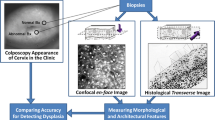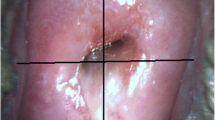Abstract
This work aims the diagnostic differentiation of chronic inflammation (CC), low-grade Intraepithelial squamous lesions (LGSIL) and high-grade intraepithelial squamous lesions (HGSIL) in biopsies of cervix of uterus from patients with atypias (ASC-US and ASC-H) and lesions (LGSIL and HGSIL), traced in the cervical/vaginal cytology by using Laser-Induced Fluorescence Spectroscopy (LIFS), with 488 nm excitation wavelength. Ninety seven biopsies from 32 patients with atypical cervical/vaginal cytology were collected. The biopsies were guided by colposcopy and taken at the squamous-columnar junction. Fluorescence emission spectra of each biopsy were collected by means of an optical fiber cable coupled to an argon laser at 488 nm as excitation source and addressed to a spectrograph and CCD camera/controller. Spectra were separated into three groups, CC, LGSIL and HGSIL, based on the cytopathology. It was detected similar mean spectra profiles for CC and LGSIL, and differences for HGSIL. An algorithm was developed for tissue classification based on the intensity of the multiplication of each spectrum by the mean spectrum of each group, searching for a discriminator that would address this spectral difference. The sensitivity and specificity of HGSIL identification, compared to CC and LGSIL was 89% and 100%, respectively. The LIFS using excitation wavelength of 488 nm could be used to differentiate HGSIL lesions from LGSIL and CC inflammation, and could help a precocious and less invasive diagnosis of cervix lesions.




Similar content being viewed by others
References
International Union Against Cancer (2006) Global Cancer Control. UICC, Geneva. <http://www.uicc.org/index.php?id=1848>. (09 Sept 2006)
World Health Organization (2006) Cancer control: knowledge into action. WHO guide for effective programmes. WHO, Geneva
National Institutes of Health (1996) Cervical Cancer. NIH Consensus Statement, 14:1–38, <http://www.ncbi.nlm.nih.gov/books/bv.fcgi? rid=hstat4.chapter.15709>. (23 July 2006)
Instituto Nacional do Câncer (2006), Ministério da Saúde. Câncer do colo de útero. <http://www.inca.gov.br/conteudo_view.asp?id=326>. (27 Ago 2006)
Derchain SFM, Neto AMP, Oliveira RLC, Santos CC, Silva JLCO (1991) Infecção por papilomavírus humano e neoplasia intra-epitelial cervical em adolescentes. J Bras Ginecol 101(11/12):499–503
Lorinez AT, Reid R, Jenson AB, Greenberg MD, Lancaster W, Kurman RJ (1992) Human papillomavirus infection of the cervix: relative risk associations of 15 common anogenital types. Obstet Gynecol 79(3):328–337
Pereyra EAG, Guerra DMM, Focchi J, Fonseca AM, Pinotti JA (1995) Atlas de colposcopia. Fundação BYK, São Paulo, pp 1–9
Zângaro RA, Silveira L Jr, Manoharan R, Zônios G, Itzkan I, Dasari RR, Van-Dam J, Feld MS (1996) Rapid multiexcitation fluorescence spectroscopy system for in vivo tissue diagnosis. Applied Optics 35(25):5211–5219
Silveira L Jr, Betiol Filho JA, Silveira FL, Zângaro RA, Pacheco MTT (2007) Laser-induced fluorescence at 488 nm excitation for detecting benign and malignant lesions in stomach mucosa. J Fluoresc 18(1):35–40
Rivoire K, Nath Z, Cox D, Atkinson N, Richard-Kortum R, Follen M (2004) The effects of repeated spectroscopic pressure measurements on fluorescence intensity in the cervix. Am J Obstet Gynecol 191(5):1606–1617
Wu Y, Xi P, Qu JY, Cheung TH, Yu MY (2005) Depth-resolved fluorescence spectroscopy of normal and dysplastic cervical tissue. Opt Express 13(2):382
Ramanujam N, Mitchell MF, Mahadevan A, Warren S, Thonsen S, Silva E, Richards-Kortum R (1994) In vivo diagnosis of cervical intraepithelial neoplasia using 337 nm excited laser induced fluorescence. Proc Natl Acad Sci USA 91(21):10193–10197
Ramanujam N, Mitchell MF, Mahadevan-Jansen A, Thomsen SL, Staerkel G, Malpica A, Wright T, Atkinson N, Richards-Kortum R (1996) Cervical precancer detection using a multivariate statistical algorithm based on laser-induced fluorescence spectra at multiple excitation wavelengths. Photochem Photobiol 64(4):720–735
Agrawal A, Utzinger U, Brookner C, Pitrics C, Mitchell MF, Richards-Kortum R (1999) Fluorescence spectroscopy of the cervix: influence of acetic acid, cervical mucus and vaginal medications. Lasers Surg Med 25(3):237–249
Nordstrom RJ, Burke L, Niloff JM, Myrtle JF (2001) Identification of cervical intraepithelial neoplasia (cin) using UV–excited fluorescence and diffuse reflectance tissue spectroscopy. Lasers Surg Med 29(2):118–127
Weingandt H, Stepp H, Baungartner R, Diebold J, Xiang W, Willemanns P (2002) Autofluorescence spectroscopy for the diagnosis of cervical intraepithelial neoplasia. Int J Gynecol Obstet 109(8):947–951
Georgakoudi I, Jacobson BC, Muller MG, Sheets EE, Badizadegan K, Carr-Locke DL, Crum CP, Boone CW, Dasari RR, Van-Dam J, Feld MS (2002) Trimodal spectroscopy for the detection and characterization of cervical precancers in vivo. Am J Obstet Gynecol 186(3):374–382
Lohmann W, MuBmann J, Lohamann C, Künzel W (1989) Native fluorescence of the cervix uteri as a marker for dysplasia and invasive carcinoma. Eur J Obstet Gynecol Reprod Biol 31(3):249–253
Ramanujam N, Mitchell MF, Mahadevan A, Warren S, Thonsen S, Silva E, Richards-Kortum R (1994) Fluorescence spectroscopy: a diagnostic tool for cervical intraepithelial neoplasia (CIN). Gynecol Oncol 52:31–38
Glassman WS, Liu CH, Tang GC, Lubicz S, Alfano RR (1992) Ultraviolet excited fluorescence spectra from non-malignant tissues of the gynecological tract. Laser Life Sci 5:49–58
Mahadevan A, Follen MF, Silva E, Thonson S, Richards-Kortunm RR (1993) Study of the fluorescence properties of normal and neoplastic human cervical tissue. Lasers Surg Med 13(6):647–655
Holcomb K, Runowicz CD (2005) Cervical cancer screening. Surg Oncol Clin N Am 14(4):777–797
Chang SK, Dawood MY, Staerkel G, Tltizinger U, Atkinson EN, Richard-Kortum RR, Follen M (2002) Fluorescence spectroscopy for cervical precancer detections is there variance across the menstrual cycle? J Biomed Opt 7(4):595–602
Tucker MJ, Morton PC, Sweitzer CL, Wright G (1995) Cryopresevation of human embryos and oocyte. Curr Opin Obstet Gynecol 7:188–192
Palmer GM, Marshek DL, Vrotsos KM, Ramanujam N (2000) Optimal methods for fluorescence and diffuse reflectance measurements of tissue biopsy sample. Lasers Surg Med 30(3):191–200
Hatch HD, Hacker NF (1998) Doença intra-epitelial do colo, vagina e vulva. In: Berek JS, Adashi EY, Hillard PA (eds) Tratado de Ginecologia, Guanabara Koogam, 12. ed. Rio de Janeiro, pp 321–349
Lima CJ, Sathaiah S, Silveira L Jr, Zângaro RA, Pacheco MTT (2000) Development of catheters with low fiber background signals for Raman spectroscopic diagnosis applications. Artif Organs 24(3):231–234
Johansson J (1993) Fluorescence spectroscopy for medical and environmental analysis, PhD Thesis, Lund Institute of Technology, Sweden
Weiss NS (1998) Clinical epidemiology. In: Rothman KJ, Greenland S (eds) Modern epidemiology. Lippincott Williams and Wilkins, 2 ed, Philadelphia, pp 519–528
Fahs MC, Mandelblatt J, Schecheter C, Muller C (1992) Cost effectiveness of cervical cancer screening for the elderly. Ann Intern Med 117(6):520–527
Burghardt E, Baltzer J, Tulusan H, Hass H (1992) Results of surgical treatment of 1208 cervical cancer studies with volumetry. Cancer 70(3):648–655
Drezek R, Sokolov K, Utzinger U, Boiko I, Malpica A, Follen M, Richards-Kortum R (2001) Understanding the contributions of NADH and collagen to cervical tissue fluorescence spectra: modeling, measurements and implications. J Biomed Opt 6(4):385–396
Drezek R, Brooker C, Pvlova I, Malpica A, Lotan R, Follen M, Richard-Kortum R (2001) Autofluorescent microscopy of fresh cervical-tissue sections reveals alterations in tissue biochemistry with dysplasia. Photochem Photobiol 73(6):636–641
Georgakoudi I, Jacobson BC, Muller MG, Sheets EE, Badizadegan K, Carr-Locke DL, Crum CP, Boone CW, Dasari RR, Van-Dam J, Feld MS (2002) NAD(H)P and collagen as in vivo quantitative fluorescent biomarkers of epithelial precancerous chances. Cancer Res 62(3):682–687
Sokolov K, Follen M, Richards-Kortum R (2002) Optical spectroscopy for detection of neoplasia. Curr Opin Chem Biol 6(5):651–658
Pavlova I, Sokolov K, Drezek R, Malpica A, Follen M, Richards-Kortum R (2003) Microanatomical and biochemical origins of normal and precancerous cervical autofluorescence using laser scanning fluorescence confocal microscopy. Photochem Photobiol 77(5):550–555
Mattos MCFL (2006) In: Montenegro MR, Franco M (eds) Patologia: processos gerais, Ed. Atheneu, 4a. ed. São Paulo, pp 210–222
Melnikow J, Nuovo J, Willian AR, Chan BKS, Howell LP (1998) Natural history of cervical squamous intraepithelial lesions: a meta-analysis. Obstet Gynecol 92(4):727–735
Richards-Kortum R, Sevick-Muraca E (1996) Quantitative optical spectroscopy for tissue diagnosis. Annu Rev Phys Chem 47:555–606
Author information
Authors and Affiliations
Corresponding author
Rights and permissions
About this article
Cite this article
Rodero, A.B., Silveira Jr., L., Rodero, D.A. et al. Fluorescence Spectroscopy for Diagnostic Differentiation in Uteri’s Cervix Biopsies with Cervical/Vaginal Atypical Cytology. J Fluoresc 18, 979–985 (2008). https://doi.org/10.1007/s10895-008-0359-5
Received:
Accepted:
Published:
Issue Date:
DOI: https://doi.org/10.1007/s10895-008-0359-5




